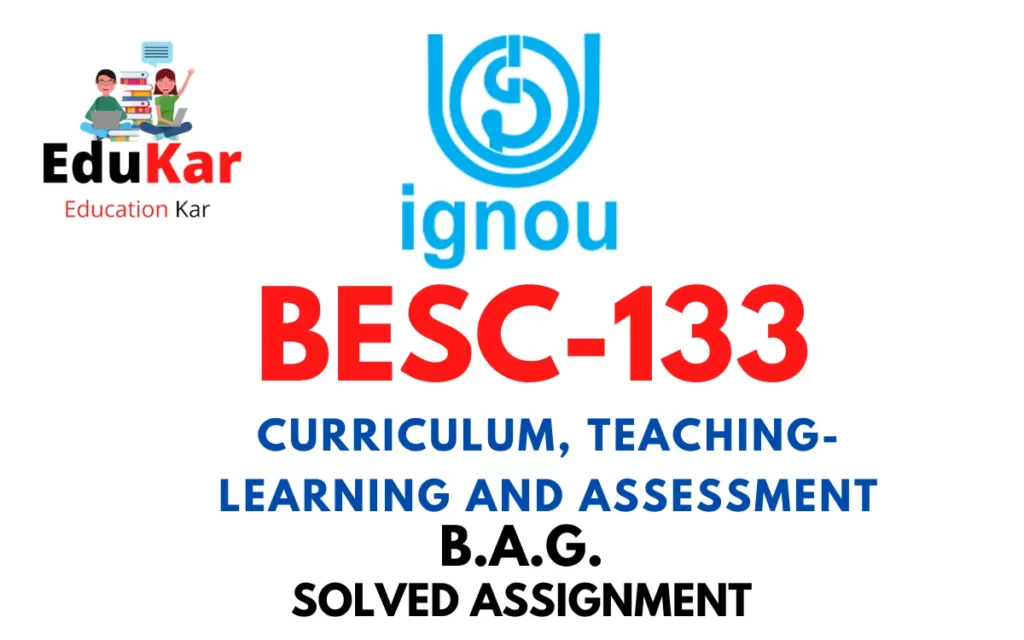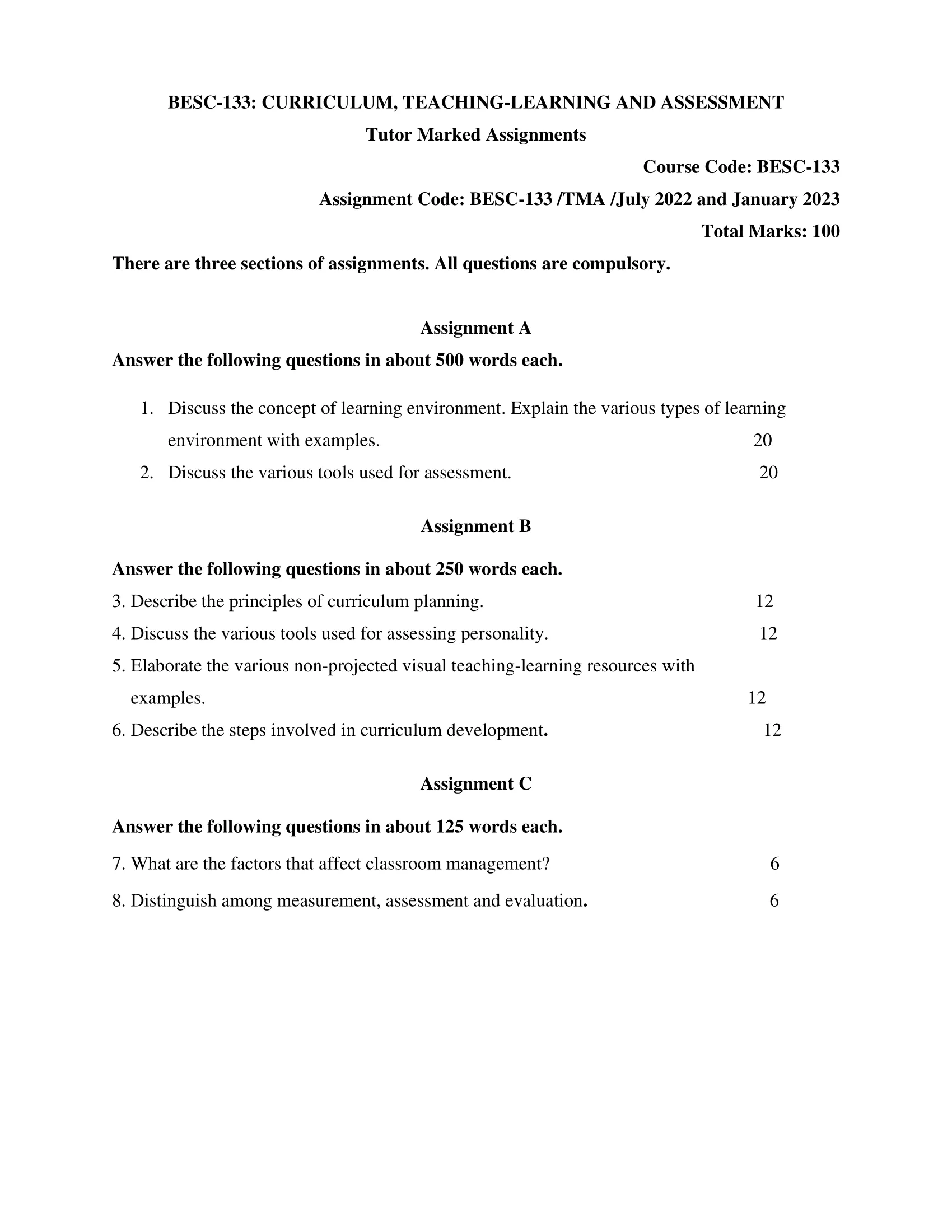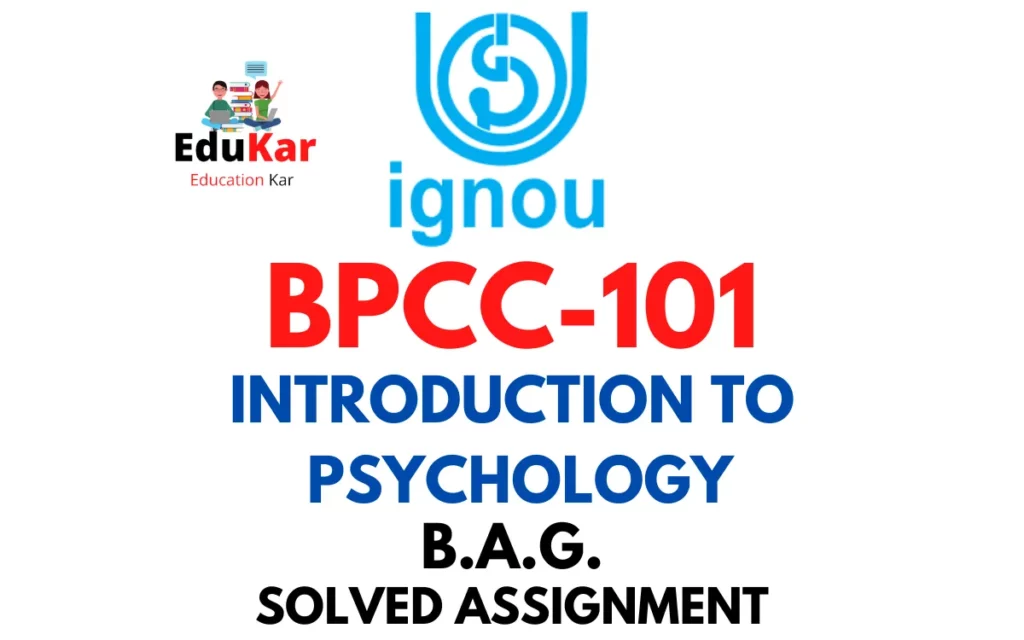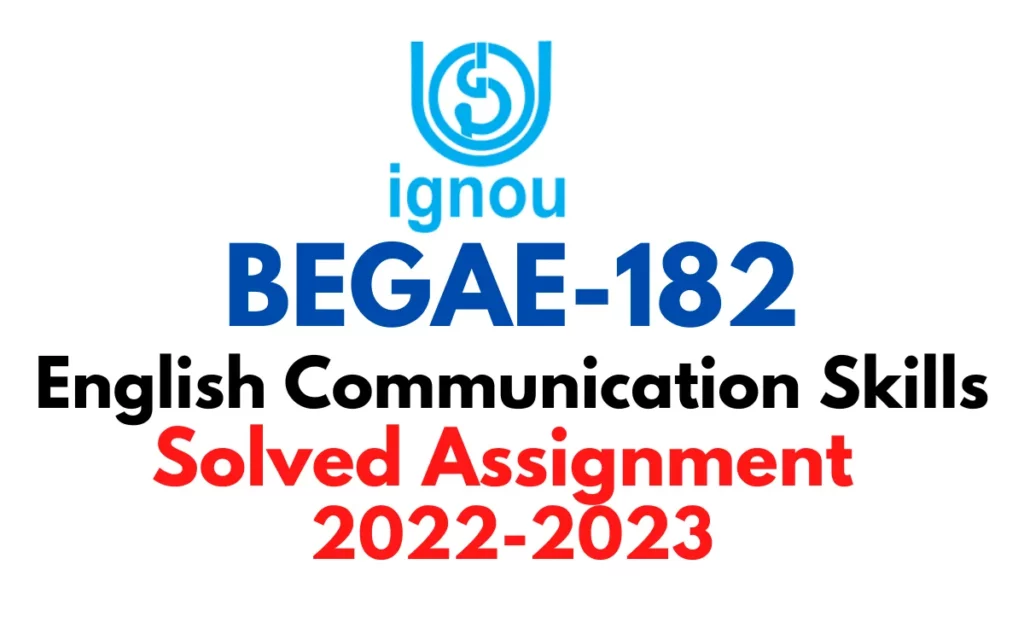Contents
- 1 Assignment A
- 2 Answer the following questions in about 500 words each.
- 3 1. Discuss the concept of learning environment. Explain the various types of learning environment with examples.
- 4 2. Discuss the various tools used for assessment.
- 5 Assignment B
- 6 Answer the following questions in about 250 words each.
- 7 3. Describe the principles of curriculum planning.
- 8 4. Discuss the various tools used for assessing personality.
- 9 5. Elaborate the various non-projected visual teaching-learning resources with examples.
- 10 6. Describe the steps involved in curriculum development.
- 11 Assignment C
- 12 Answer the following questions in about 125 words each.
- 13 7. What are the factors that affect classroom management?
- 14 8. Distinguish among measurement, assessment and evaluation.

| Title | BESC-133: IGNOU BAG Solved Assignment 2022-2023 |
| University | IGNOU |
| Degree | Bachelor Degree Programme |
| Course Code | BESC-133 |
| Course Name | CURRICULUM, TEACHING-LEARNING AND ASSESSMENT |
| Programme Name | Bachelor of Arts (General) |
| Programme Code | BAG |
| Total Marks | 100 |
| Year | 2022-2023 |
| Language | English |
| Assignment Code | BESC-133 /TMA /July 2022 and January 2023 |
| Assignment PDF | Click Here |
| Last Date for Submission of Assignment: | For June Examination: 31st April For December Examination: 30th September |

Assignment A
Answer the following questions in about 500 words each.
1. Discuss the concept of learning environment. Explain the various types of learning environment with examples.
Ans: A learning environment refers to the physical, social, and emotional setting in which learning occurs. It encompasses the overall environment in which teaching and learning take place, including the physical space, resources, social interactions, and cultural factors that influence learning. The learning environment can have a significant impact on student learning outcomes, motivation, and engagement.
There are several types of learning environments, each with its unique characteristics and features. These include:
- Traditional classroom environment: This is the most common type of learning environment where students attend a physical classroom and are taught by a teacher. This environment usually includes desks, whiteboards, textbooks, and other traditional teaching resources.
- Online learning environment: This type of learning environment uses digital technology to deliver content and facilitate interaction between teachers and students. Online learning environments may include virtual classrooms, online discussion forums, and video conferencing.
- Blended learning environment: This environment combines traditional classroom learning with online learning. It allows for a more flexible approach to learning by integrating digital tools with face-to-face instruction.
- Experiential learning environment: This type of environment provides students with hands-on, real-world experiences that facilitate learning. Examples of experiential learning environments include internships, co-op programs, and service learning projects.
- Collaborative learning environment: This environment emphasizes group work and collaboration among students. It encourages peer-to-peer learning and allows students to learn from one another.
- Informal learning environment: This type of environment occurs outside of formal classroom settings and includes learning experiences that are self-directed or based on personal interests. Examples of informal learning environments include museums, libraries, and online communities.
2. Discuss the various tools used for assessment.
Ans: Assessment is a critical process in education and other fields, which involves evaluating the performance, knowledge, skills, and abilities of individuals or groups. There are various tools used for assessment, and some of them are:
- Tests and exams: These are formal assessments that measure knowledge, skills, and abilities in a specific subject or area. Tests and exams can be multiple-choice, essay-based, or performance-based, and they are often used to evaluate students’ progress in academic courses.
- Surveys and questionnaires: Surveys and questionnaires are tools used to gather information about a specific topic or group of people. They can be used to measure attitudes, opinions, and behaviors, and they are often used in social science research.
- Observation: Observation is a method of assessing performance and behavior by watching and recording what individuals do in a specific situation. Observation can be used in various settings, such as classrooms, workplaces, and healthcare facilities.
- Portfolios: Portfolios are collections of work that demonstrate an individual’s progress and achievement over time. Portfolios can include written assignments, projects, and other forms of work, and they are often used in academic settings.
- Interviews: Interviews are conversations between two or more people, used to gather information about knowledge, skills, experiences, and attitudes. Interviews can be structured or unstructured and can be used in various settings, such as employment and healthcare.
- Performance assessments: Performance assessments are assessments that measure an individual’s ability to perform a specific task or set of tasks. Performance assessments can be used in various settings, such as sports, music, and healthcare.
- Self-assessment: Self-assessment is a process where individuals evaluate their own knowledge, skills, and abilities. Self-assessment can be used in various settings, such as education and employment.
- Rubrics: Rubrics are scoring tools used to evaluate performance or achievement based on specific criteria. Rubrics can be used in various settings, such as education and employment.
Assignment B
Answer the following questions in about 250 words each.
3. Describe the principles of curriculum planning.
Ans: Curriculum planning is a critical aspect of education that involves the design, development, and implementation of educational programs. The process of curriculum planning is guided by a set of principles that help ensure that the educational program is effective, meaningful, and relevant. Here are some key principles of curriculum planning:
- Alignment with learning goals: The curriculum should be aligned with the learning goals of the educational program. It should be designed to ensure that students acquire the knowledge, skills, and attitudes needed to achieve these goals.
- Integration of content: The curriculum should integrate a range of content areas, including academic subjects, vocational and technical training, and life skills. The content should be relevant, meaningful, and engaging for students.
- Differentiation: The curriculum should be designed to meet the diverse learning needs of students. It should be flexible and adaptable to meet the needs of students with different learning styles, abilities, and backgrounds.
- Assessment and evaluation: The curriculum should include a system of assessment and evaluation to measure student progress and identify areas of strength and weakness. It should also provide feedback to teachers and students to guide instruction and improve learning outcomes.
- Cultural relevance: The curriculum should be culturally relevant and responsive, reflecting the diversity of students’ backgrounds and experiences. It should include materials and resources that represent different cultures and perspectives.
- Collaboration and participation: The curriculum should be designed in collaboration with teachers, students, and other stakeholders. It should involve students in the planning process and encourage their active participation in learning.
- Continuous improvement: The curriculum should be reviewed and evaluated regularly to ensure its effectiveness and relevance. It should be updated and revised based on feedback from teachers, students, and other stakeholders to improve student learning outcomes.
4. Discuss the various tools used for assessing personality.
Ans: Assessing personality is an important aspect of psychology, and there are several tools and methods available to assess personality. These tools are used to measure various traits, characteristics, and behaviors that make up an individual’s personality. Some of the most commonly used tools for assessing personality are:
- Self-Report Inventories: Self-report inventories are questionnaires that individuals complete to describe their own personality. These inventories typically include a range of questions that ask about various traits, attitudes, and behaviors. Examples of self-report inventories include the Myers-Briggs Type Indicator (MBTI) and the Big Five Personality Inventory.
- Projective Techniques: Projective techniques involve presenting individuals with ambiguous stimuli, such as inkblots or pictures, and asking them to describe what they see. The idea behind this technique is that the individual’s interpretation of the stimuli will reflect their personality. Examples of projective techniques include the Rorschach Inkblot Test and the Thematic Apperception Test (TAT).
- Behavioral Observation: Behavioral observation involves watching individuals in a natural setting and recording their behavior. This approach is used to assess personality based on observable behaviors, such as social skills, assertiveness, and emotional expression.
- Interviews: Interviews are another tool used to assess personality. This involves a structured conversation between the individual and the assessor, where the interviewer asks questions about the individual’s personality, behaviors, and attitudes.
- Neuroimaging: Neuroimaging techniques such as fMRI and PET scans can be used to study the brain and its functioning. This method provides insights into the neurological basis of personality and can be useful in identifying brain regions associated with specific personality traits.
5. Elaborate the various non-projected visual teaching-learning resources with examples.
Ans: Non-projected visual teaching-learning resources refer to educational materials that do not require a projector or screen to be used in the classroom. These resources are often used to enhance learning by providing visual aids that help students understand and retain information. Here are some common non-projected visual teaching-learning resources along with examples:
- Whiteboards and chalkboards: These are traditional teaching tools used for writing notes, equations, and diagrams. They can be used to brainstorm ideas, illustrate concepts, and solve problems.
- Posters and charts: These are large visuals that display information, such as timelines, maps, and graphs. They can be used to summarize key concepts, present data, and provide context for learning.
- Models and diagrams: These are three-dimensional and two-dimensional representations of objects and concepts. They can be used to show the inner workings of machines, the structure of molecules, or the relationships between different elements in a system.
- Graphic organizers: These are visual aids used to organize and structure information. Examples include mind maps, flowcharts, and concept maps. They can help students understand complex topics by breaking them down into smaller, more manageable parts.
- Realia and artifacts: These are real objects and artifacts that are used to illustrate concepts and ideas. Examples include fossils, historical documents, and cultural artifacts. They can help bring a lesson to life and provide students with a tangible connection to the material.
- Interactive displays and exhibits: These are hands-on displays and exhibits that allow students to interact with the material in a more engaging way. Examples include science museums, history exhibits, and interactive digital displays.
6. Describe the steps involved in curriculum development.
Ans: Curriculum development is a process of designing, developing, and implementing educational programs. The process involves several steps to ensure that the curriculum is effective, relevant, and aligned with the goals of the educational program. Here are the typical steps involved in curriculum development:
- Needs assessment: The first step in curriculum development is to conduct a needs assessment to identify the learning needs of the target audience. This involves gathering information on the knowledge, skills, and attitudes required to achieve the desired learning outcomes.
- Defining learning outcomes: Based on the needs assessment, the next step is to define the learning outcomes that the curriculum will address. These outcomes should be specific, measurable, and achievable.
- Selecting content and resources: Once the learning outcomes are defined, the next step is to select appropriate content and resources that support the learning objectives. This may include textbooks, multimedia resources, and other educational materials.
- Developing instructional strategies: Based on the learning outcomes and the selected content, instructional strategies should be developed to facilitate learning. This may involve selecting appropriate teaching methods, designing activities, and developing assessment tools.
- Creating assessment methods: The curriculum should include assessment methods that allow for the evaluation of student learning. These methods should be aligned with the learning outcomes and should provide feedback to both students and teachers.
- Implementation: The curriculum should be implemented in a systematic and consistent manner. This may involve training teachers on the curriculum, developing schedules, and providing support to ensure successful implementation.
- Evaluation and revision: The curriculum should be evaluated regularly to ensure its effectiveness and relevance. Based on the evaluation, revisions may be made to the curriculum to improve learning outcomes.
Assignment C
Answer the following questions in about 125 words each.
7. What are the factors that affect classroom management?
Ans: There are several factors that can affect classroom management, including:
- Classroom size: The size of the classroom can impact how manageable it is for a teacher to maintain control and provide individual attention to students.
- Student behavior: The behavior of students can affect classroom management, especially if there are disruptive or difficult students who need extra attention.
- Teacher behavior: The way that a teacher interacts with students, sets rules and expectations, and manages the classroom can impact the overall classroom environment.
- Classroom layout: The way that the classroom is arranged and organized can affect the ease of management and how well students can engage with the learning environment.
- School culture: The culture and norms of the school can impact classroom management, as well as the support and resources available to teachers for managing their classrooms.
8. Distinguish among measurement, assessment and evaluation.
Ans: Measurement, assessment, and evaluation are three terms used in the context of data analysis and research. While these terms are often used interchangeably, they refer to distinct processes.
Measurement refers to the process of assigning numerical values or labels to data. It involves the use of instruments or tools to quantify variables, such as weight, height, and temperature.
Assessment refers to the process of gathering information and making judgments about an individual’s knowledge, skills, abilities, or performance. Assessment can be conducted using a variety of tools and methods, such as tests, questionnaires, and interviews.
Evaluation refers to the process of making judgments about the quality, value, or effectiveness of a program, product, or service. Evaluation involves comparing actual performance to established standards or goals and making decisions about the program or product based on the results of the evaluation.
How to Download BESC-133 Solved Assignment?
You can download it from the www.edukar.in, they have a big database for all the IGNOU solved assignments.
Is the BESC-133 Solved Assignment Free?
Yes this is absolutely free to download the solved assignment from www.edukar.in
What is the last submission date for BESC-133 Solved Assignment?
For June Examination: 31st April, For December Examination: 30th October





![[Solved Assignment] BPCS 185-DEVELOPING EMOTIONAL COMPETENCE (IGNOU-BAG) 2022-2023 [Solved Assignment] BPCS 185-DEVELOPING EMOTIONAL COMPETENCE (IGNOU-BAG) 2022-2023](https://edukar.in/wp-content/plugins/contextual-related-posts/default.png)





![[Solved Assignment] BPCS 188-APPLICATIONS OF SOCIAL PSYCHOLOGY (IGNOU-BAG) 2022-2023 BPCS 188-APPLICATIONS OF SOCIAL PSYCHOLOGY IGNOU BAG Solved Assignment 2022-2023](https://edukar.in/wp-content/uploads/2023/01/BPCS-188-APPLICATIONS-OF-SOCIAL-PSYCHOLOGY-IGNOU-BAG-Solved-Assignment-2022-2023-1024x640.webp)



